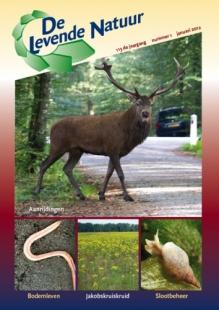De Levende Natuur nummer 1 van 2012 (English summary)
Afbeelding

Soil can help to prohibit the presence of Ragwort
T.F.J. van de Voorde, W.H. van der Putten & T.M. Bezemer
Ragwort (Jacobaea vulgaris) is a species, that can reach high abundances in ex-arable fields that are used for nature restoration in The Netherlands. The plant is also poisonous for cattle and horses, so Ragwort causes a lot of attention to the control of this species. In a series of ten former arable fields that differ in time since abandonment of agricultural practices we show that the abundance of Ragwort increases, reaching peak abundance after approximately five years, but thereafter quickly declines. In a greenhouse study ragwort performance was strongly reduced in soil that was conditioned before by Ragwort. Also in soil that was conditioned by plant species that co-occur with Ragwort in the old-fields the presence of Ragwort was reduced. Here we suggest to use this negative soil effect in the control of Ragwort.
Ungulate-vehicle collisions in a forested landscape: the Veluwe
G.W.T.A. Groot Bruinderink, D.R. Lammertsma & G.J. Spek
The Veluwe is a 90.000 ha forested area in the central parts of The Netherlands. The area is inhabited by increasing numbers of wild ungulates as for example wild boar, red deer and roe deer. As a consequence the number of ungulate-vehicle collisions grew over the past 20 years. We studied the effects of human, animal and environmental characteristics on these collisions. We concluded their number was affected by ungulate density and daily and seasonal patterns in their activity. We found a positive effect of traffic volume and the presence of forest near roads and a negative effect of the width of a road and the availability of mast, an important food resource for all ungulates, in particular for the wild boar. We found no effect of daily, weekly or monthly hunting pressure. High densities of wild ungulates are the outcome of traditional management. A study is therefore recommended of census data and culling statistics over the past 20 years in order to find the effects on ungulate numbers and movements.
Response of freshwater snail to ditch management
H.H. van Kleef
The Netherlands are covered with many kilometres of ditches, habitat for many species of plants and aquatic invertebrates. Their main purpose is transport of water and therefore they are kept free of abundant macrophyte growths. Removal of these macrophytes is performed in a way that invertebrate populations are preserved, despite a high mortality of individuals. However, high mortality may in theory induce changes in the expression of life history traits. Therefore a pilot study was performed to assess the response of two model species of freshwater snails (Lymnea stagnalis and Planorbarius corneus) to ditch maintenance. Managed ditches were cleared of macrophytes on a yearly basis, and in unmanaged ditches no such intensive recurring measures were taken.
In managed ditches L. stagnalis produced more eggs and consequently were heavier than in unmanaged water bodies. They also appear to have a higher growth rate and lower expected lifespan in managed ditches. Energy for increased growth and reproduction appears to come from behavioural responses. They became faster active after being disturbed and tended to spend more time crawling and feeding. P. corneus did not show a similar response in reproduction or weight, probably due to a different life cycle timing. However they showed similar responses in activity.
The observed adaptive responses may be genetically or phenotypically in nature. At present it is not yet possible to distinguish between these two. If the observed changes are genetically in nature they may have profound consequences for the future of influenced populations in managed ditches. These populations will become less suitable as sources for colonising new and more natural waters, because the populations become increasingly adapted to the unnatural conditions of managed ditches. Therefore, solely maintaining populations may prove not to be enough and care should be taken to preserve genotypes that are adapted to natural conditions.
Nitrogen retention by soil biota to combat impacts of soil acidification on understory cover in forests
R.H. Kemmers
Upon acidification by atmospheric deposition many forests show a monotonous understory cover dominated by grasses and shrubs outcompeting rare and vulnerable Red List species. Frequently applied measures like liming and top soil removal, to restore a more diverse species composition appeared not effective. We supposed that also soil fauna has been affected by acidification processes and that this might cause disturbed nitrogen cycling in forest soils, favouring a raised nitrogen availability for primary production. Over a wide range of primary sites we selected in triplo acidified and unaffected forest soils based on species composition. In the upper soil we determined pH-KCl, N-total and organic matter content, nitrogen pools in soil biota, carbon and nitrogen mineralization rates, and nitrogen flows. We derived regression models to predict N-mineralization and –immobilization fluxes from soil chemical characteristics and N-pools in soil biota. It appeared that acidification is likely to cause a decreased activity of bacteria, protozoa and earthworms, but an enhanced biomass of fungi, nematodes and enchytraeids. At the same time the soils internal nitrogen balance shifted from nitrogen retention through the bacteria-protozoa-earthworm channel of the soils food web towards N-mineralization through the fungi-(mites)-nematodes-enchytraeids channel. Consequently nitrogen retention by soil fauna is turning into an increased net nitrogen mineralization in favour of primary production and a predominance of competitive species in the understory cover. Restoration measures should focus on an increased nitrogen retention and immobilization by reactivating soil fauna.

